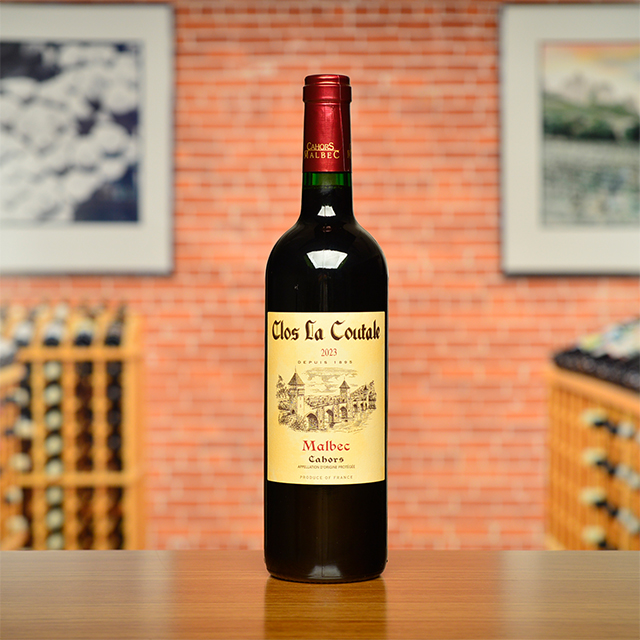Notify me
2021 Cahors
Clos La Coutale
If you are as eager as I am to enter the season of stews, roasts, and game, you cannot go wrong with Clos La Coutale’s earthy and spicy Cahors as your new go-to rouge. Originating halfway between Bordeaux and Montpellier, this blend of mostly Malbec and a splash of Merlot has both the class and rusticity to make a pot that’s been braising for hours on your stove feel at once comforting and refined. The notes of plum, brambly fruit, and leather sing alongside a cassoulet or duck confit. If nearby Bordeaux, where Coutale’s Philippe Bernède sources the grand cru barrels for this bottling, is the polished and urbane one in the family, Cahors is the sneakily sophisticated but humbler country cousin, loaded with personality you’ll enjoy getting to know.
—Tom Wolf
| Wine Type: | red |
| Vintage: | 2021 |
| Bottle Size: | 750mL |
| Blend: | 80% Malbec, 20% Merlot |
| Appellation: | Cahors |
| Country: | France |
| Region: | Southwest |
| Producer: | Clos La Coutale |
| Winemaker: | Philippe Bernède |
| Vineyard: | 60 ha |
| Soil: | Gravel, Limestone, Clay |
| Aging: | Aged in foudre and 1-2 years old barrels from Bordeaux grand cru for one year before bottling |
| Farming: | Traditional |
| Alcohol: | 13.5% |
More from this Producer or Region

2023 Cahors
France | Southwest
Today, the 2023 is a robust, tightly coiled rouge balanced by notes of dark fruit, plum, earth, and eucalyptus. It’s sure to unfurl slowly over the next twenty years.

2023 Cahors
France | Southwest
La Grave is one of the rare Cahors to consist exclusively of the native Malbec. Without any Merlot to soften it, this Cahors is decidedly old-fashioned.

2021 Irouléguy Rouge “Cuvée Haitza”
France | Southwest
A black wine made from steep inclines planted to Tannat and some Cabernet Sauvignon, it demands patience while its dense, mouth-coating tannins slowly release their clutching grip.

2023 Irouléguy Blanc “Schistes”
France | Southwest
Lean, wiry, and crackling even with a few years of age—and with more, it will evolve into a delight of textured mouthfeel and petrol waxiness on the nose.

2022 Irouléguy Blanc “Hegoxuri”
France | Southwest
Any lover of whites from Chablis or the Loire should try this white made of Gros Manseng, Petit Manseng, and Petit Courbu.
 /
/
About The Producer
Clos La Coutale
Today, Cahors’ jack-of-all-trades and Renaissance man, Philippe Bernède, continues the family tradition with both heart and ingenuity. Philippe’s vines rest upon the gentle slopes that rise up from the Lot River. Over the years, Philippe has tinkered with the house blend to achieve a greater equilibrium. Today, the blend consists of 80% Malbec and 20% Merlot, creating an intense wine that juggles elegant rusticity with everyday drinkability. Coutale has quite a record of age-worthiness as well and Philippe is not afraid to pull out older vintages of his wines alongside much more expensive Bordeaux. They stand up pretty well! Nothing beats bécasse (woodcock) or cassoulet with an old Coutale, but a simple steak fits the bill just fine.
About The Region
Southwest

Tucked away beneath Bordeaux and buffeted by the Pyrenees to the south, this expansive region of France, commonly known as the Southwest, is home to a diverse number of viticulture and gastronomic traditions as well as cultures. Though Cahors might be the most well known (and easiest to pronounce) appellation from the Southwest, the importance and influence of French Basque culture cannot be underestimated. Irouléguy, the primary appellation of the Basque region of France produces full-bodied, hearty red wines, produced from Tannat grape (known for its tannic qualities). Dry whites from Irouléguy are also produced from Petit and Gros Manseng. Northeast of Irouléguy is the sweet wine-producing appellation of Jurançon. These moelleux wines made from Petit and Gros Manseng have a storied history in France, from being the first wine region to have a vineyard classification, which dates back to the 154th century, to being preferred wine of royalty dating back to the 16th century as well as the French poet Colette.
More from Southwest or France
2012 Pomerol
Château Gombaude-Guillot France | Bordeaux
2022 Irouléguy Blanc “Hegoxuri”
Maison Arretxea France | Southwest
2023 Cahors
Château La Grave France | Southwest
2024 Côtes-du-Rhône Blanc “Pantomine”
Maxime-François Laurent France | Southern Rhône
2023 Sancerre “Les Cris”
Daniel Chotard France | Loire
2021 Irouléguy Rouge “Cuvée Haitza”
Maison Arretxea France | Southwest
2023 Crozes Hermitage “Tiercerolles”
Barruol / Lynch France | Northern Rhône
2023 Irouléguy Blanc “Schistes”
Maison Arretxea France | Southwest
2024 Muscadet Côtes de Grand Lieu sur lie “La Nöe”
Eric Chevalier France | Loire
2023 Cahors
Clos La Coutale France | Southwest
2022 Tavel “La Combe des Rieu”
Gaël Petit France | Southern Rhône
2024 Val de Loire Sauvignon Blanc “Unique”
Domaine du Salvard France | Loire
2012 Pomerol
Château Gombaude-Guillot France | Bordeaux
2022 Irouléguy Blanc “Hegoxuri”
Maison Arretxea France | Southwest
2023 Cahors
Château La Grave France | Southwest
2024 Côtes-du-Rhône Blanc “Pantomine”
Maxime-François Laurent France | Southern Rhône
2023 Sancerre “Les Cris”
Daniel Chotard France | Loire
2021 Irouléguy Rouge “Cuvée Haitza”
Maison Arretxea France | Southwest
2023 Crozes Hermitage “Tiercerolles”
Barruol / Lynch France | Northern Rhône
2023 Irouléguy Blanc “Schistes”
Maison Arretxea France | Southwest
2024 Muscadet Côtes de Grand Lieu sur lie “La Nöe”
Eric Chevalier France | Loire
2023 Cahors
Clos La Coutale France | Southwest
2022 Tavel “La Combe des Rieu”
Gaël Petit France | Southern Rhône
2024 Val de Loire Sauvignon Blanc “Unique”
Domaine du Salvard France | Loire
Kermit once said...

Kermit once said...
Great winemakers, great terroirs, there is never any hurry. And I no longer buy into this idea of “peak” maturity. Great winemakers, great terroirs, their wines offer different pleasures at different ages.
Inspiring Thirst, page 312














